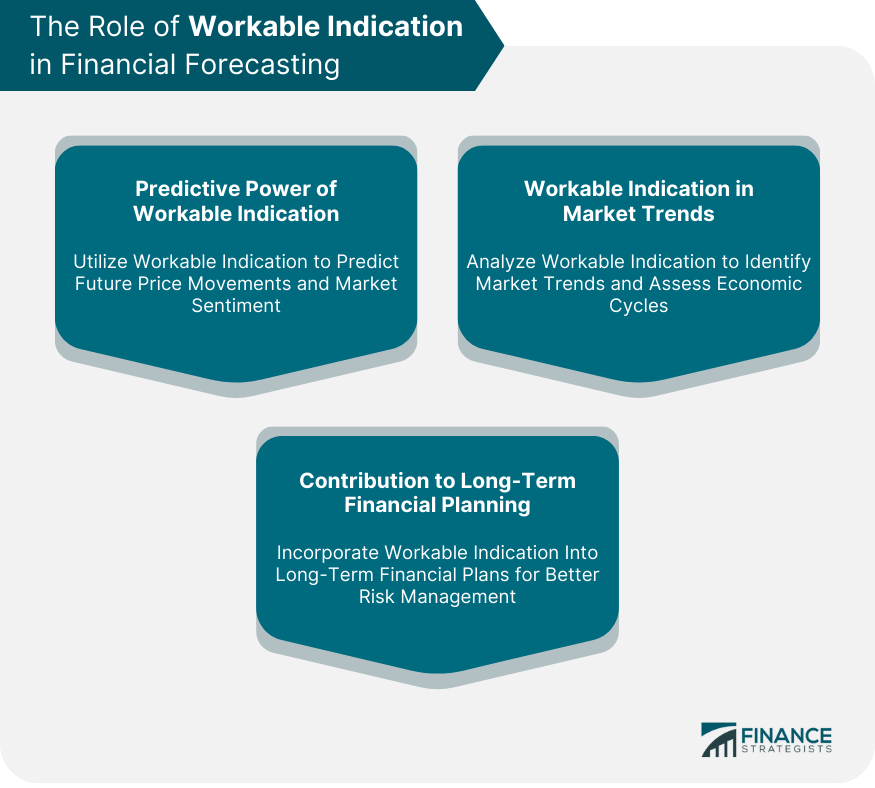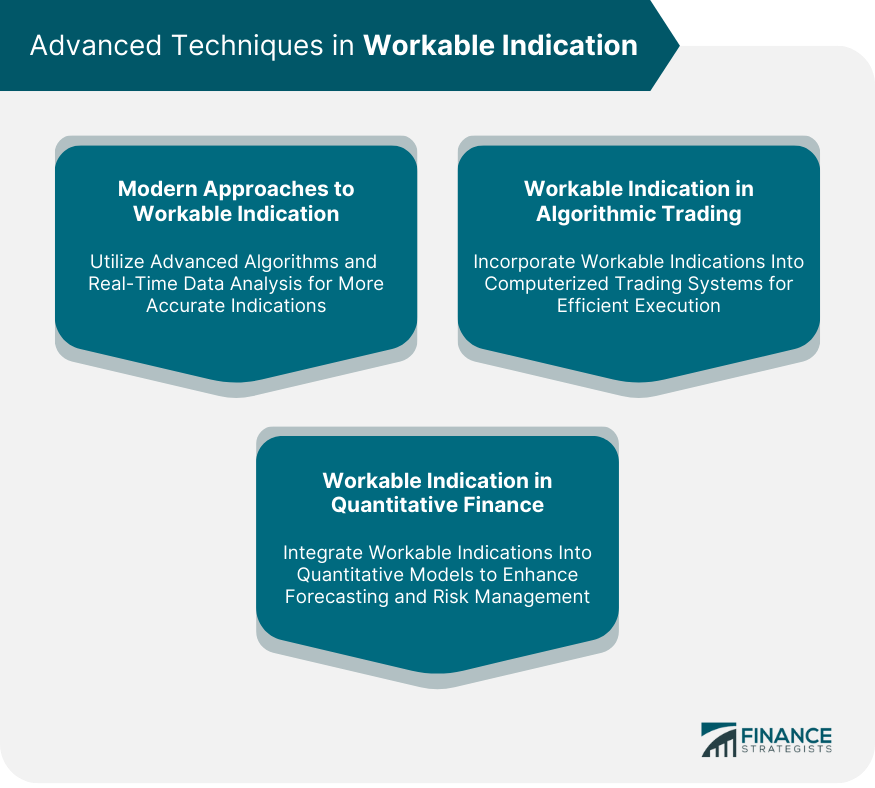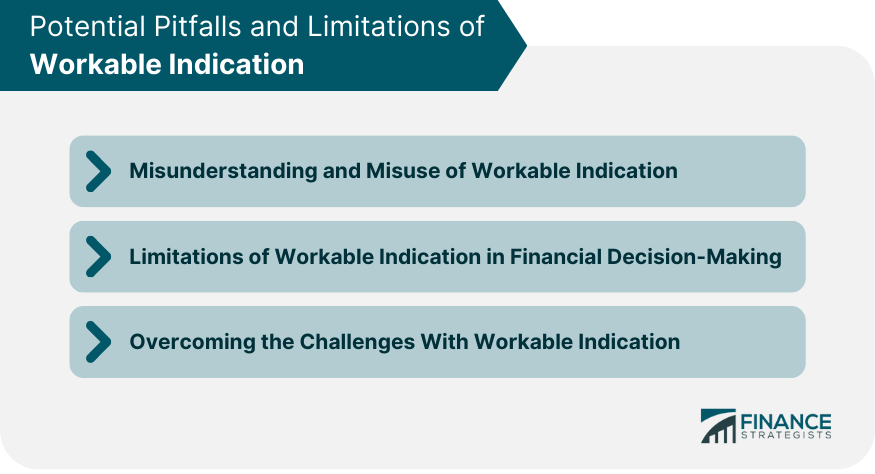A Workable Indication is a term used in the financial industry to represent an estimated range within which security could likely be bought or sold in the current market conditions. It is often used as a measure of liquidity and can provide insights into potential price movements. This information is valuable for traders, investors, and wealth managers as it helps them make informed decisions about when to enter or exit positions, manage risk, and strategize their investment or trading plans. A workable indication is not a guarantee of trading at specific prices but rather a guide based on current market data and sentiment. In the bond market, workable indications can play a significant role in pricing. Since bonds often trade over the counter rather than on centralized exchanges, price transparency can be challenging. Workable indications provide a solution by giving market participants a sense of where bonds could trade. This can influence the pricing of bonds and impact trading strategies. The workable indication can also affect the perceived yield and duration of bonds. Since it estimates the potential trading range, it can influence expectations about future cash flows and thus impact yield calculations. Similarly, changes in workable indications could impact perceived duration, particularly for bonds with embedded options. While workable indication is fundamentally a reflection of current market conditions, it can also have predictive power. Changes in workable indications can signal shifts in market sentiment, potentially forecasting future price movements. However, it's important to note that workable indication is just one of many factors that can influence prices. It should be used in conjunction with other indicators and analysis techniques. The workable indication can also provide insights into broader market trends and economic cycles. For instance, narrowing workable indications across a range of securities could signal increasing market confidence and a potential uptrend. On the other hand, widening workable indications suggest rising uncertainty and a potential downturn. In the context of long-term financial planning, workable indications can help investors understand the potential price range of their investments, aiding in risk assessment and portfolio construction. While it's not a tool for predicting specific future prices, it can provide valuable information about market conditions and potential price volatility, informing investment decisions and risk management strategies. In recent years, the approach to workable indication has evolved significantly with advancements in technology and the growing influence of machine learning and AI. Modern trading systems can generate workable indications using complex algorithms that analyze vast market data in real time. This can provide more accurate and timely indications, enabling traders to make quicker and more informed decisions. Workable indication has a particular role in algorithmic trading, where computer programs execute trades based on predefined rules. Algorithms can use workable indications to inform their trading decisions, adjusting the timing and size of trades based on the current trading environment. This can result in more efficient execution and better trading outcomes. Quantitative finance, which applies mathematical and statistical methods to financial markets, also utilizes workable indications. Quantitative models can incorporate workable indications to forecast price movements better and manage risk. For example, a model could use changes in workable indications to signal to change market sentiment or liquidity conditions, triggering adjustments in trading strategies. Despite its usefulness, workable indications can sometimes be misunderstood or misused. Some traders may view it as a guaranteed trading range, which it is not. It's important to remember that a workable indication is an estimate based on current market conditions and can change rapidly. Misinterpreting or over-relying on this tool can lead to poor trading decisions and potential financial losses. The workable indication also has inherent limitations. It is primarily based on market data and does not consider fundamental factors like a company's financial health or macroeconomic conditions. Therefore, it should be used as a complement to, rather than a replacement for, thorough financial analysis. Additionally, in less liquid markets or during times of market stress, workable indications may become less reliable due to wider spreads and increased price volatility. Despite these challenges, the value of workable indication in financial decision-making should not be underestimated. Traders and investors can overcome these hurdles by understanding the nature and limitations of workable indication and using it as part of a broader analytical toolkit. Continuous education, training, and practice can help market participants make the most of this valuable tool. A workable indication is an estimated security trading range that provides valuable insights into liquidity and potential price movements in the financial industry. It aids traders, investors, and wealth managers in making informed decisions about entering or exiting positions, managing risk, and strategizing investment or trading plans. However, it is important to understand that a workable indication is not a guarantee of trading at specific prices but rather a guide based on current market data and sentiment. Workable indications play a significant role in bond pricing and can impact bond yield and duration calculations. They also have predictive power, reflecting shifts in market sentiment and providing insights into market trends and economic cycles. Incorporating workable indications into long-term financial planning helps assess risk and inform investment decisions. Advanced techniques such as algorithmic trading and quantitative finance utilize workable indications for efficient execution and risk management. However, it is crucial to be aware of potential pitfalls and limitations, including misunderstanding, misuse, and the need for complementing thorough financial analysis. Overcoming these challenges requires continuous education and using workable indications as part of a broader analytical toolkitWhat Is a Workable Indication?
Understanding the Influence of Workable Indication on Bond Pricing
How Workable Indication Affects Bond Yield and Duration
Role of Workable Indication in Financial Forecasting
Predictive Power of Workable Indication
Workable Indication in Market Trends and Economic Cycles
How Workable Indication Contributes to Long-Term Financial Planning

Advanced Techniques in Workable Indication
Modern Approaches to Workable Indication
Workable Indication in Algorithmic Trading
Workable Indication in Quantitative Finance

Potential Pitfalls and Limitations of Workable Indication
Misunderstanding and Misuse of Workable Indication
Limitations of Workable Indication in Financial Decision-Making
Overcoming the Challenges With Workable Indication

Bottom Line
Workable Indication FAQs
A Workable Indication is a term used in financial markets to represent a price range where security could reasonably be bought or sold. It estimates the current liquidity and potential price movements for a particular security.
Wealth managers use Workable Indication to get a sense of the potential buying or selling price of securities. This helps in effective portfolio management, optimization of investment strategies, and risk assessment.
Workable Indication plays a significant role in bond pricing and trading. Since bonds often trade over-the-counter, workable indications provide a sense of where bonds could trade, influencing their pricing and impacting trading strategies.
While Workable Indication offers valuable insights, it has limitations. It is based on market data and doesn't consider fundamental factors like a company's financial health or macroeconomic conditions. Also, in less liquid markets or during times of market stress, workable indications may become less reliable due to wider spreads and increased price volatility.
The future of Workable Indication is likely to be shaped by continued innovation and technological advancements, such as AI and machine learning. It could also play a role in the growing field of sustainable and ESG investing, helping investors assess market dynamics. As the financial industry becomes more data-driven, understanding and interpreting Workable Indications will be a valuable skill.
True Tamplin is a published author, public speaker, CEO of UpDigital, and founder of Finance Strategists.
True is a Certified Educator in Personal Finance (CEPF®), author of The Handy Financial Ratios Guide, a member of the Society for Advancing Business Editing and Writing, contributes to his financial education site, Finance Strategists, and has spoken to various financial communities such as the CFA Institute, as well as university students like his Alma mater, Biola University, where he received a bachelor of science in business and data analytics.
To learn more about True, visit his personal website or view his author profiles on Amazon, Nasdaq and Forbes.











